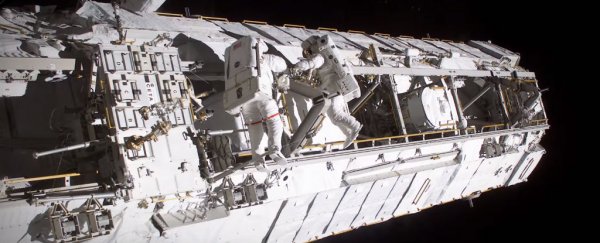Space is big - no one's going to fight you on that fact - but the enormity of our cosmic backyard and the crazy physics that govern everything beyond it can be tough to comprehend. So tough, the unofficial rule is if you think you've got it all figured out, you probably understand very little. It's no wonder that misconceptions about space are so easily spread among us, but do you want to know the best thing about getting the facts straight? The actual science is far more fascinating than those myths will ever be.
In the episode of Mental Floss above, Elliott starts off with a really basic fact that so many of us get wrong, mostly because we don't really think about it that much - the Sun might look like a burning ball of flames, but it isn't actually on fire.
Our favourite giant ball of gas is actually burning thanks to the process of nuclear fusion that goes on in its core, where 600 million tonnes of hydrogen gas are being converted into 596 million tonnes of helium every single second. This allows it to emit light and heat, but there's no actual fire involved because for that you need a whole lot of oxygen, which doesn't exist.
Speaking of the Sun, it seems like common sense to say that Mercury is the hottest planet in our Solar System because it's the closest to the Sun, but that honour actually goes to Venus - the second closest planet to the Sun.
As the video explains, proximity to the Sun actually has little to do with a planet's average temperature. Venus is the hottest planet not because of the distance between it and the Sun, but because of its extremely thick atmosphere. This means that the surface of Venus maintains temperatures of about 462 degrees Celsius, while the surface temperature of Mercury fluctuates dramatically, and often drops to -173 degrees Celsius at night.
NASA gets a pretty bad rap when it comes to space pens - you might remember an episode of The West Wing where they talk about how NASA spent millions of dollars in the 60s developing a pen that would work in microgravity, while the Soviet Union just gave their cosmonauts pencils. This isn't actually true, and NASA has the receipts to prove that they too were using mechanical pencils at the time. Later, an anti-gravity space pen was developed for around US$1 million, but this was used by both the US and Russians.
Space is a vast, inhospitable wasteland full of things that would kill you a million times over without the correct protective gear, but contrary to popular opinion, you won't explode if you somehow end up in orbit without a spacesuit, and you won't get sucked in by the vacuum of a black hole if you find yourself in the vicinity of one.
I'll let Elliott explain why in the video above, but let's just say you'd get seriously wrecked if you ended up in either of these situations, but not in the ways you might be imagining. That might be cold comfort if someone pushes you out of a spacecraft without your suit one day, but at least you'll know what's coming.
